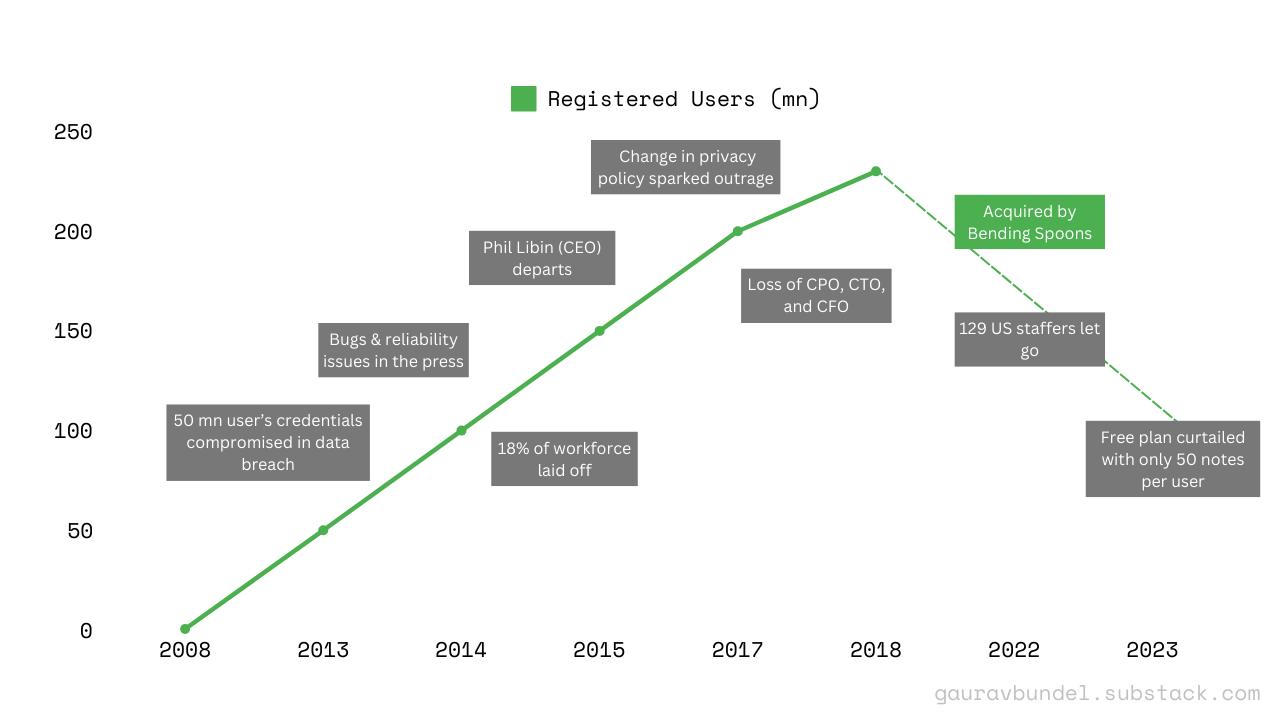Where do tech giants go to die?
Evernote's slow decline and its implications for subscription businesses
Do you remember the scene of the elephant graveyard from the movie The Lion King? It’s where aging elephants go to, after leaving their herd, to spend their last remaining days alone.
This romantic idea has a parallel in the digital world as well. Much like the mighty mastodons, there are digital products that were once invincible but have become shells of their past selves, slowly fading into irrelevancy. They have lost their users, employees, and founders who once made them great. But in their decline, they leave valuable lessons for us to develop a healthy skepticism to look past the hype. (I’m looking at you, LLMs).
If you are a millennial like me, you might remember an app with a green elephant logo - Evernote. Originally launched as a Windows app in 2004, its fortunes turned when Phil Libin took over as the CEO. He was instrumental in launching it in the Apple Store in 2008, the same year as the iPhone.
Evernote started as a simple note-taking app. Just add what you have in mind to the cloud’s memory and retrieve it when you need it later. Slowly, it became the go-to app for personal productivity with its nifty features like cross-platform availability and web clipper to save anything on the internet. I remember being amazed at saving a note on my PC browser and seeing it appear on my Android phone.
16 years later, it finds itself without any of its original developers, sold to an Italian serial acquirer who is trying to salvage what it can of this old digital relic. It laid off most of its US employees and restructured the business model to pay-first use-later, in sharp contrast to all the popular note-taking apps in the market.
The Green Elephant Goes Tumbling Down
Evernote faced multiple setbacks over the past decade. During this time, it went from its peak of over 230 mn registered users to a fraction of that. When a lumbering giant like Evernote falls, it does not do all of a sudden. Here’s how it pans out:
It hits a roadblock,
then another one
then it tries to correct itself
and it stumbles again
And so on it goes.
Everything, Evernote, All At Once
In hindsight, Evernote had everything going for it and nothing at the same time. While its user base was growing exponentially, the same users were struggling with bugs, privacy issues, and ill-thought-out pricing changes. Internally, it was seeing layoffs, leadership shuffles, and cost-cutting measures.
All this while, it was trying different approaches to make the pie larger. It acquired Skitch (an app to add captions to photos), launched new services like Evernote Food (a recipe & food photo-sharing app), and even ventured into physical goods with office accessories. These failed to see adoption and had to be shuttered or subsumed in the main app. For a product that promised to “Remember everything”, ironically, its leadership forgot what made it great.
The bane of Evernote was monetization. Over the years, it acquired 230 million users but most of them (~96% at one point) were using it for free. This failure to monetize its gigantic user base led it on multiple paths never arriving anywhere. Ultimately, the founding CEO Phil Libin’s hunch - the longer users stay, the more likely they are to pay - came to naught. And he moved on to new, more exciting ventures.
New executives tried to run the ship differently. After raising $300 million of venture capital funds over the years, they tried focusing on self-sufficiency post-2017 and managed to pull in $100 million in recurring revenue however profitability was still out of reach. In 2018, it emerged that paid & active user growth had remained flat for the last six years. The freemium model was not working and not all of it was Evernote’s doing.
Times change
Note-taking app users broadly fall into two groups: collectors who save every link, text, or email they receive to search later and writers who capture what’s in their heads and add notes intentionally. Building an app for each requires different thinking. Collectors need a cross-platform app that connects to the web and other apps they use. Writers need an intuitive and clutter-free design to capture any thought.
Their needs have changed over time. Today, they need AI capabilities to synthesize their thoughts and provide quick answers. They also need to connect with other people and apps, necessitating collaboration and integration capabilities. The blurring boundaries between work & life mean a productivity app needs to be flexible enough to do both.
Not all would like to pay for these, though, especially when they are spoiled for choices. Platform-specific apps like Google Keep, Apple Notes, or One Note and cross-platform productivity darlings like Notion, Roam, and Obsidian provide everything Evernote ever did and more for free.
These new productivity tools now do what Evernote tried for years to do: successfully straddle the personal and work lives of their users. For instance, Notion’s free individual plan works as an acquisition channel for its paid business users. Evernote tried to do this with Business, Work Chat, and Context but introduced slowdowns and bugs instead.
Trudging Along
The forward momentum of a large organism can sustain the movement even if it’s a downward spiral. Bending Spoons, the new owner, took a contrarian bet by severely limiting the free tier focusing only on paying users. But it's not looking to acquire new users anyway.
Here’s what Federico Simionato, Evernote product lead at Bending Spoons, mentioned in 2024
We think mostly about our existing customers just because they are so many. We definitely don’t want to piss them off. I don’t think, we’d want to make Evernote worse to our existing customers because we want to entice new users.
The focus is on retaining existing customers for whom switching platforms is a sentimental decision since years of personal memories are locked in Evernote.
And therein lies the catch. A subscription product’s growth depends a lot on what the future holds. To improve constantly, it needs new challenges. When you stop acquiring new users because you’re focused on retention, you limit those new challenges. Even employees & partners want to work with companies solving “cool” problems. All of this feeds the irrelevancy cycle and eventually existing users lose interest and move on to new (and better) tools.
The ones who stay are driven by nostalgia, loyalty, or laziness. It remains to be seen if these alone can save Evernote from fading into oblivion. Or, will it live only in our collective memory? It’s poetic to think that its slogan “Remember everything” can be thought of as the last cry of this dying digital pachyderm. Yes, “dying”, because the law of entropy applies to all things - whether they are carbon-based or silicon-based.









Survive and Thrive
The business organization model requires immediate integration and collaboration with other AI-led apps, especially given the current hype. Many lack note-dense competency, making it difficult to capture a strong user base. Consider corporations and companies that do not rely on services from giants like Microsoft, Google, or AWS, instead opting for revenue-sharing or risk-sharing models.
Relevance and relatability—the pillars of survival in today’s fast-paced, app-driven industry.